
Namco Limited was a Japanese multinational video game and entertainment company founded in 1955 which operated video arcades and amusement parks globally, produced video games, films, toys, and arcade cabinets. They were one of the most influential figures in the worldwide coin-op and arcade game industry; Namco produced several multi-million-selling game franchises, such as Pac-Man, Galaxian, Tekken, Tales, Ridge Racer, and Ace Combat. In 2006, Namco merged with Bandai to form what is now named Bandai Namco Holdings; the standalone Namco brand continues to be used for video arcade and other entertainment products by the group's Bandai Namco Amusements division.

Xevious is a vertically scrolling shooter arcade video game developed and published by Namco in 1982. It was released in Japan by Namco and in North America by Atari, Inc. Controlling the Solvalou starship, the player attacks Xevious forces before they destroy all of mankind. The Solvalou has two weapons at its disposal: a zapper to destroy flying craft, and a blaster to bomb ground installations and enemies. It runs on the Namco Galaga arcade system.

Rally-X is a maze chase arcade video game developed in Japan and Germany by Namco and released in 1980. In North America, it was distributed by Midway Manufacturing and in Europe by Karateco. Players drive a blue Formula One race car through a multidirectional scrolling maze to collect yellow flags. Boulders block some paths and must be avoided. Red enemy cars pursue the player in an attempt to collide with them. Red cars can be temporarily stunned by laying down smoke screens at the cost of fuel. Rally-X is one of the first games with bonus stages and continuously-playing background music.
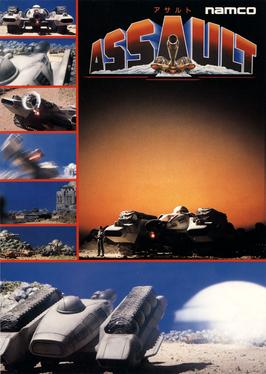
Assault is a 1988 multi-directional shooter arcade game developed and published by Namco. It was licensed to Atari Games for release in North America. Controlling a caterpillar-tread self-propelled gun, the player is tasked with completing each of the game's eleven stages while shooting enemies and avoiding projectiles. It uses a twin-stick control layout, similar to games such as Battlezone. The plot involves the human race searching for new planets after Earth reaches its maximum population - after discovering an exo-planet 35,000 light years away from the Milky Way, they enslave the planet's natives and take control, leading to the planet's native population vowing to abolish the humans and bring peace to their world. The protagonist who rides the aforementioned self-propelled gun which players control, is one such native.
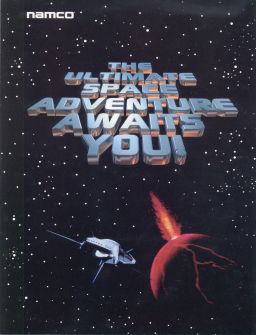
Galaxian3: Project Dragoon is a 3D rail shooter video game developed and published by Namco. It was originally a theme park attraction designed for the International Garden and Greenery Exposition in Japan, and was later released as an arcade game in 1992. The game involves players controlling a starship named the Dragoon in its mission to destroy Cannon Seed, a superweapon set to destroy what is left of the human race.

Grobda is a 1984 multidirectional shooter arcade video game developed and published by Namco. It is a spin-off from Xevious, as the player's tank first appeared in that game as an enemy. It runs on Namco Super Pac-Man hardware but with a video system like that used in Mappy and The Tower of Druaga, and it also uses a DAC for the "Get Ready" speech sample at the start of each round.

Dragon Spirit is a 1987 vertical-scrolling shooter arcade game developed and published by Namco. In North America, it was distributed by Atari Games. Controlling the dragon Amur, the player must complete each of the game's nine areas to rescue the princess Alicia from the demon Zawell. Similar to Namco's own Xevious, Amur has a projectile weapon for destroying air-based enemies and a bomb for destroying ground enemies. It ran on the Namco System 1 arcade board.

Super Xevious is a vertically scrolling shooter released as an arcade video game in Japan in 1984. It was developed and published by Namco as an updated version of Xevious (1982) created as a response to the overwhelming success of the original in Japan. It was sold as conversion kit for existing Xevious cabinets.

Namco Classic Collection Vol. 1 is a 1995 arcade game compilation developed and published by Namco. It includes three of the company's most well-known games from the early 1980s — Galaga (1981), Xevious (1983), and Mappy (1983) — alongside brand-new "Arrangement" remakes of these games that have updated gameplay, visuals, and sounds. The arcade originals are also modified slightly to end after a certain number of rounds. Super Xevious (1984) is also playable. It ran on the Namco ND-1 arcade system, being one of the first games to utilize it.
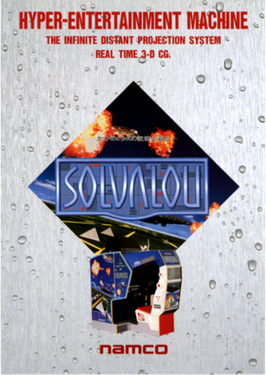
Solvalou is a 1991 first-person rail shooter arcade game developed and published in Japan by Namco. The sixth entry in the Xevious series, the player takes control of the Solvalou starship from a first-person perspective as it must destroy the Xevious forces before they take control of Earth. The Solvalou has two weapon types: an air zapper to destroy air-based enemies, and a blaster bomb to destroy ground-stationed enemies. It runs on the Namco System 21 arcade board.

Xevious 3D/G is a 1996 vertically scrolling shooter arcade video game developed and published by Namco. The eighth entry in the Xevious series, it combines 2D-based gameplay with 3D gouraud-shaded polygon graphics. Players control the Solvalou starship in its mission to destroy a rogue supercomputer named GAMP and the Xevian Forces, using two basic weapon types - an air zapper to destroy air targets, and a blaster bomb to destroy ground targets. The game also features destructive power-ups, new bosses, and two player simultaneous play.

Metal Hawk is a 1988 multidirectional shooter arcade video game developed and published by Namco. Assuming control of the titular attack helicopter, the player is tasked with using a machine gun and air-to-surface missiles to destroy enemies and earn a certain number of points before the timer runs out, all while avoiding collision with ether enemy projectiles and obstacles. The Metal Hawk can change its altitude to allow it to either rise higher in the air or lower towards the ground. It runs on the Namco System 2 arcade board.
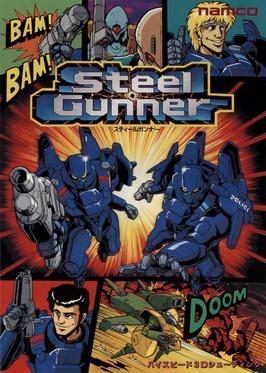
Steel Gunner is a 1990 first-person shooter arcade game developed and published by Namco. Players take control of Garcia and Cliff, a duo of police officers that are part of the Neo Arc police force, as they must use their powerful Gargoyle mecha suits to destroy the STURM terrorist organization, who have taken captive scientists Dr. Ryan and Dr. Ellis to create a world-ending superweapon. Gameplay revolves around using a crosshair to shoot down enemies and avoid harming civilians. It runs on the Namco System 2 Plus arcade hardware.

NebulasRay is a vertical-scrolling shooter arcade game developed and released by Namco in 1994. Players take control of a starship named the Fighting Ray through a series of levels in its mission to eradicate the universe of an intergalactic organization named the Master Force. It is noteworthy for its usage of pre-rendering, where 3D models are converted into 2D sprites, creating the illusion of a 3D world.
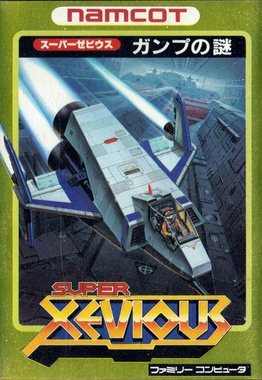
Super Xevious: GAMP no Nazo is a 1986 vertically scrolling shooter video game developed and published by Namco for the Family Computer in Japan. It is the sequel to Xevious, a popular arcade game released in late 1982, and the fourth installment in the Xevious franchise overall. The player controls a spaceship named the Solvalou in its mission to destroy a powerful supercomputer named GAMP, which took over Earth during an ice age. GAMP no Nazo features a heavy focus on puzzle-solving, with each of the game's 21 levels posing a puzzle that must be solved to progress.

Xevious: Fardraut Saga is a 1988 vertically scrolling shooter video game published by Namco for the MSX2 in Japan. An updated PC Engine version was released two years later. The fifth entry in the Xevious franchise, the player controls a spaceship in its mission to vanquish the Xevious forces before its supercomputer leader GAMP wipes out the entirety of mankind. The player uses two weapons, an air zapper to destroy air-based enemies, and a blaster bomb to destroy ground-based enemies.
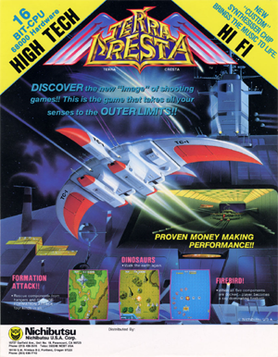
Terra Cresta is a vertically scrolling shooter arcade video game released by Nihon Bussan in 1985. The player controls a flying craft to destroy the Mandler army before they destroy all of humanity. Gameplay involves shooting enemies and collecting different ship parts that each provide their own unique weapon, such as a wave gun or a double shot. It is the sequel to the 1980 fixed shooter Moon Cresta, Nihon Bussan's first big hit in arcades and the second installment of the Cresta Series.
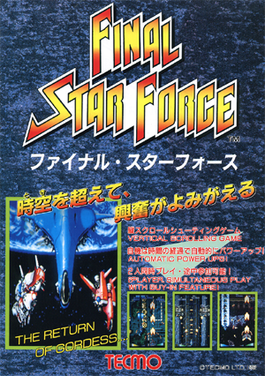
Final Star Force is a vertically scrolling shooter developed by Tecmo and published as an arcade video game by Tecmo in 1992. It is the third and final entry in its Star Force series, and retains many of the same mechanics as its predecessors. Players control the two space fighter ships Blue Nova and Red Nova. There are three different power-ups to choose from called "Pulsators". The power meter itself charges up automatically to increase their fighters' power.

Thunder Ceptor is a 3D rail shooter arcade game that was released by Namco in 1986. It usurped both Libble Rabble and Toy Pop as the company's most powerful 8-bit arcade games, was the first game from them to use an analogue (360-degree) joystick. A stereoscopic 3-D sequel, 3-D Thunder Ceptor II, was released towards the end of the year.




















